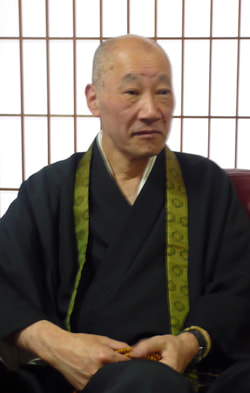
Shomyo Urai, the chief steward of Kan-eiji Temple
We talked with Shomyo Urai, the chief steward of Kan-eiji Temple, who has studied the history of Ueno.
Q: Kan-eiji Temple is just like a treasure-house of history, and has preserved a variety of commemorative things. There is the tomb of Kenzan Ogata in the temple precincts, isn't there?
Urai: It is not a tomb. It is a monument. His tomb is located at Zenyoji Temple in Sugamo. The tomb was originally located near JR's switchyard, but then it was transferred to Sugamo. The reason why that monument is placed here is as follows; Naohiko Masaki, the former president of Tokyo University of the Arts, made a replica of the monument, and donated it to Kan-eiji Temple because the original location of the tomb was in Ueno.
Q: I have hard that there was once Kan-eiji-saka Station near Kan-eiji Temple.
It was a station of Keisei Electric Railway. It is still located outside of the temple's private postern, on the right side of the street. You can find it if you go up the Kan-eiji-saka street and look right. Keisei Electric Railway closed the station a long time ago. I think it is now being used as a warehouse.
Q: Did people use the station in the past?
Trains used to stop at Nippori Station, Kan-eiji-saka Station and Hakubutsukan-dobutsuen Station and finally reach Ueno Station, so there were too many stations. Hakubutsukan-dobutsuen Station was also shut down recently. Now trains run from Nippori Station to Ueno Station, but, in the past, two more stations existed between them. First, Kan-eiji-saka Station was closed, and then Hakubutsukan-dobutsuen Station was closed after the Second World War. Originally, Keisei Electric Railway did not have a plan to connect to Ueno Station. Although it is little-known, the railway company planned to run trains from Nippori to Asakusa. However, the company built the tightly curved railroad in order to connect to the station from where Keisei Skyliners arrive and depart.
Q: There are two different stories in Taito City. One is Asakusa and Ueno in the Edo Period and the other is the Ueno and Asakusa area in the Showa, Taisho and Meiji Eras. People in Asakusa say that the period of Meiji modernism is most appropriate for Asakusa. They also say that there is Sensoji Temple so a taste of Edo still remains. How can we appreciate each period and atmosphere of Ueno?
Well, actually, I was asked by a person in Asakusa to talk about Ueno and Asakusa, and made a speech. It might be a little different from your question. Basically, in a sense, Ueno and Asakusa have continued to be notable sites and entertainment districts from the Edo Period to the present Heisei Period.(continued in the right column)
There are also Kan-eiji Temple and Sensoji Temple, which were called "holy place" in the Edo Period, and the place is accompanied by a variety of entertainment and others. I think there is no other place which has developed in this way while preserving relics of the Edo Period. In short, the most basic point is that those temples have existed in this area. According to Noboru Miyata, a folklorist, from the viewpoint of folklore, it is quite natural that a holy place is accompanied by shopping districts, notable sites and entertainment districts. Necessary condition for that is the existence of mountains and water such as river. So Sensoji Temple and Kan-eiji Temple represent water and a hill of Ueno respectively.
In terms of folklore, holy places must have mountains and water. Another interesting point Miyata said is that Sensoji Temple and Kan-eiji Temple enshrine "Chingo Daimyojin," a deity of a raccoon dog, and "Ana Inari," a deity of a fox, respectively. Such scenic spots and places of historic interest are certainly accompanied by spirits of animals that correspond to spirits of lands, which Miyata said are also underlying conditions that holy places should satisfy. The following is my thought; Asakusa became a notable site in the Edo Period, which also had an entertainment district. Ueno was also a notable site and entertainment district. There are many materials depicting notable sites and entertainment districts in Edo, but there were not so many notable sites that also had entertainment districts. Asakusa and Ueno met these conditions. What lies behind this is the notion of "holy place" which was pointed out by Miyata.
Then, Asakusa changed significantly after the Meiji Restoration, and was divided into six blocks. The sixth block became a show district. Asakusa was transformed into the show district that is the sixth block, while being a notable site/entertainment district which was developed in the Edo Period. Regarding the Ueno area, the Meiji Government took up most of the grounds of Kan-eiji Temple, and cultural facilities were built in the area. Therefore, both Ueno that has cultural facilities and Asakusa that has a show district have kept entertainment districts and characteristics as notable sites. In that sense, Ueno and Asakusa are exceptional regions. Taito City is the smallest ward among the 23 wards, and has retained the two major entertainment districts that have undergone some changes. In that sense, the notion that Asakusa reflects the Meiji Era as its symbol is slightly wrong. The point is how it transformed itself in the Meiji Period while retaining the Edo Period's characteristics, so the base lies in the Edo Period. Few entertainment districts, such as Ryogoku and Nihonbashi, have continued to exist. This small city has the two entertainment districts, Ueno and Asakusa, which have different characters and continue to exist from the past to the present. I think Taito City should care about this point.(continued in the next page)

Shomyo Urai, the chief steward of Kan-eiji Temple














